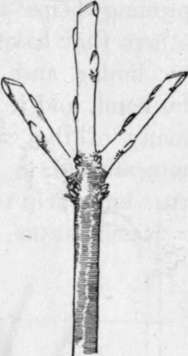Gooseberries
Description
This section is from the book "School Gardening", by W. Francis Rankine. Also available from Amazon: School Gardening.
Gooseberries
Gooseberries have a strong tendency to form thick, impenetratable bushes, and once this state is reached, the grower is face to face with trouble. Under such conditions a heavy crop of small fruit results, and the trouble of gathering it is great. Hence, close attention must be given to pruning, and generally speaking, the advice given under Red and White Currants should be followed. The young growths should be cut back to three or four leaves, but one or two young shoots may be retained on the branches of well-established trees, as they will produce a few exceptionally fine fruits ; at the same time, the fact that Gooseberries carry the bulk of their crop on spurs must never be overlooked.
The Magpie Moth (A braxas grossulariata). The caterpillar of this moth is very destructive to the foliage of Gooseberries and Currants. The moth itself is a familiar object in most fruit gardens, appearing in July and the beginning of August. Eggs are placed on the leaves and the caterpillars which eventually appear are able to hibernate. For this purpose they may enter the soil below the trees or avail themselves of shelter as it offers itself in crevices. In the following spring, when the young leaves appear, the caterpillars carry on their destructive work. In June they enter the pupal state and the striped chrysalis may be found suspended from the underside of the leaves or under the eaves of outhouses in the vicinity of the bushes. In order to keep this pest under control pruning helps to dislodge some of the caterpillars ; others that have reached the soil may be exterminated by liming and hoeing. The larvae may be removed by hand, and if the bushes are gently yet firmly shaken many of the caterpillars are dislodged. It might be remembered in the interests of our feathered friends that birds help to remove numbers of this pest.

Fig. 58. pruning red currants.
The new wood is cut back as shown so that the spurs may develop fruit buds.
Continue to:
